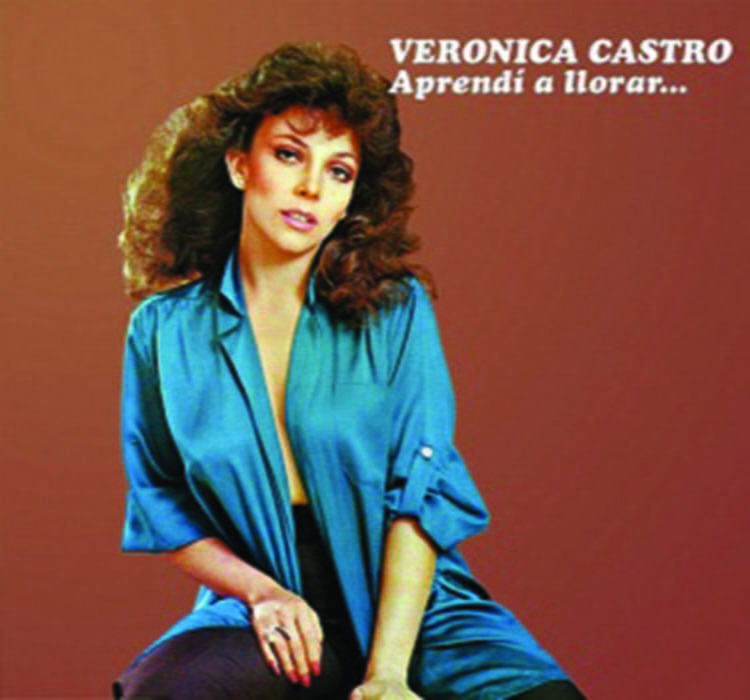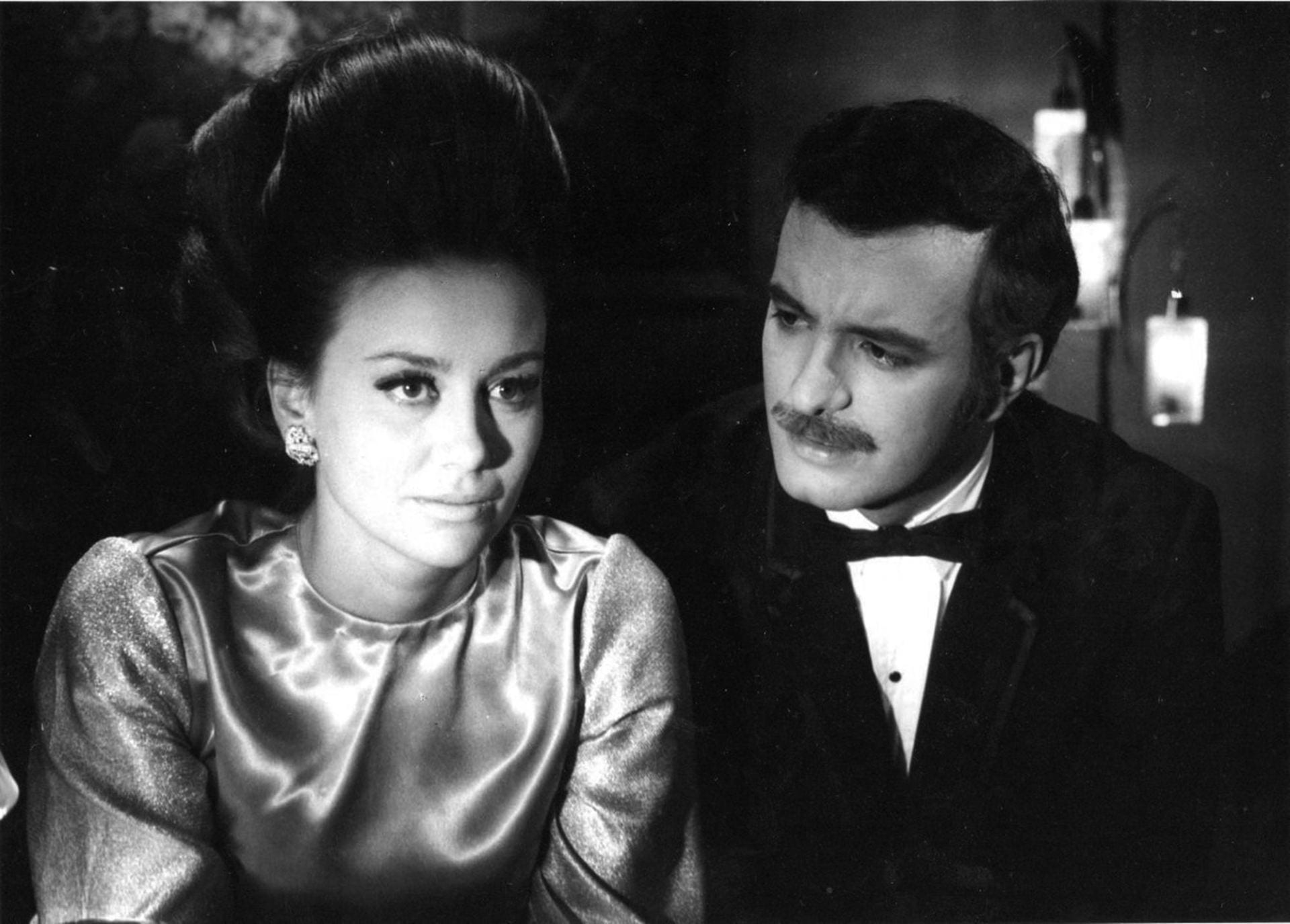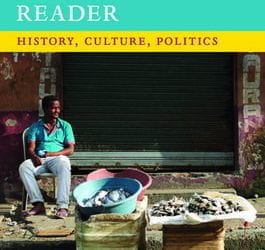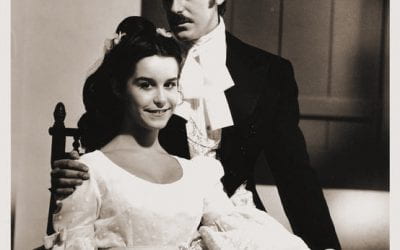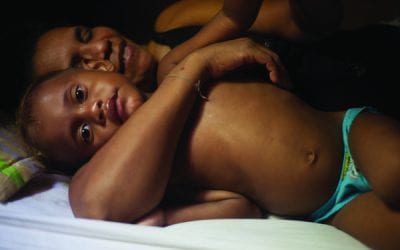Telenovela Heroines
I first became interested in telenovelas as an academic subject when, more than thirty years ago, I heard my then two-year-old daughter sing a song for the first time. It was the opening theme from the 1979 telenovela Los ricos también lloran (The Rich Also Cry), starring Verónica Castro. I realized that the melodrama and its well-known manipulation of emotions had got a hold of my toddler. “Aprendí a llorar”—I learned to cry—was the song’s constant refrain. And it wasn’t just my little girl whom the show attracted: Los ricos también lloran (perhaps one of the best telenovela titles to date) introduced the genre with great success to several European countries, as well as to Russia and China. And much of that success can be attributed to its protagonist, Verónica Castro, and her character, the beautiful and brave Mariana.
Following the example of Julieta (of Romeo and Juliet) and of Melibea (from the Celestina, originally known as the tragicomedy of Calixto and Melibea), telenovela heroines are very active risk-takers who surrender body and soul to the tasks at hand. In the amorous duel of the telenovela, in the tremendous struggles narrated in the stories, the existence of other is always present. Because it is not only a matter of falling in love with the wrong person. It is that this love is an impossible love; it is a prohibited love, which challenges all the expectations and mandates established generation after generation. It is a love that is difficult to recognize: it emerges first as a game of attraction or rejection—or sometimes evan an initial head-on confrontation. I observed that the heroines are almost always humiliated in the stories, much more so than the male protagonists. It is a simpler affair for the male characters, who are permitted to court whom they wish regardless of social status or indulge in purely sexual attraction.
For the heroines, love is revealed as something extremely powerful that shakes them up, that keeps them on tenterhooks, that challenges them. They deny it, they struggle against their very selves; they engage in self-deception…until, finally, they accept the nature of this love. They feel it in their body. And they do not doubt it any more. And this acceptance transforms them, redeems them, gives them a strength they were lacking or of which they were not aware. Then, they grow. They are capable of confronting the hostility of their social class, to take on cultural and religious differences. The certainty of love gives them the energy to overcome any obstacle.
This fledgling love must confront obstacle after obstacle. It’s always at risk. It is a love that is difficult to recognize, to maintain or to recuperate. It seems practically impossible that this couple (up until now, heterosexual) can unite to construct something together, to realize their dreams. They manage to survive separations, misunderstandings, meddling by others and difficulties that only increase with each episode. Perhaps to prove that it is genuine, it is a love that must overcome time, distance or the most terrible catastrophes one can imagine. Often, the lovers spend years apart, each living in remote places without having any certainty that the loved one is still alive.
In all these struggles, the heroines shine. And many of them do not correspond to the archetype of Cinderella, the poor and suffering princess waiting for her prince.
I’m going to tell you about my favorite heroines—a deliberately arbitrary selection. Although I certainly recognize their merits, I was never captivated by the telenovelas made by the Venezuelan Grecia Colmenares in the 1980s and 90s: Topacio, in Venezuela, later María de nadie, Grecia, Pasiones, Manuela and others in Argentina. They did not have the “physique du rol” needed for an active part. Their appearance characterized them as too naive and undemonstrative, and their acting never managed to overcome appearances . These telenovelas didn’t move me. An angelical style, unruffled from the first to last episode. Something similar could be said about the 1990s films made by Mexican telenovela icon Thalía, the so-called “trilogy of the three Marías,” María Mercedes, Marimar and María la del barrio. I know that my own particular likes and dislikes don’t necessarily jibe with popular taste, since these telenovelas were wildly popular and had thousands of fans all over the world. Marimar, in particular, amused me and the naivete of its protagonist was funny, but I’d characterize this series as a humorous program—not the kind of telenovela that touches my soul.
In contrast, the Mexican telenovela star Verónica Castro, in the 1970s and 80s, depicted heroines who went from being humiliated, made fun of, scorned, to blooming through an internal transformation. El derecho de nacer, Los ricos también lloran, Rosa salvaje, Mi pequeña Soledad—all have this characteristic. The heroine at first is untamed, neglected, crazy. But she grows. She learns to control her destiny and gains true love.
The heroines of the Colombian telenovelas Café (1994) and Yo soy Betty, la fea (1999), both by Fernando Gaitán, are among my favorites. It’s not only that they are valiant, flip their lives upside down, and achieve both love and personal growth. It’s also that they are working women and successful in their own right. The workplace is predominant in both telenovelas, and these heroines are comfortable in the work world and in business. They didn’t inherit success and they aren’t daughters or wives of some powerful man. They got where they are through their own merit, through study and with an enormous effort. La Gaviota, in Café, went from being a peasant coffee picker to becoming manager of an international coffee business. These heroines have more leeway than other protagonists: Gaviota suffers, sings and gets drunk. And Betty, who shines during business meetings, rescues the textile business through her sheer intelligence when the owner’s bad business decisions put it on the verge of bankruptcy. The owner is the one with whom Betty is secretly in love without having any hope of being reciprocated. The interesting thing about Betty is that the protagonist continues to be ugly during almost all of the telenovela. And her boss falls in love with her, despite that fact. A change in her look—more a matter of internal self-esteem than surgery or radical embellishments—transforms Betty into a beautiful, as well as talented, woman.
Argentine telenovelas also had strong heroines in the 1990s, especially those played by Andrea del Boca (Antonella, Celeste, Perla Negra). These heroines, in all her telenovelas, were undisputed protagonists, without a suitor or a cast to overshadow them. Intelligent, cheeky and always sure of themselves.
But why am I talking so much about old telenovelas from the last decades of the 20th century? Because in recent years, the transformation of the telenovela genre went in a direction that had more to do with business pressures than their own melodramatic development.
In the 21st century, the telenovela has become ever more transnational. Years of telenovelas have put an emphasis on showing off bodies, as, for example in Pasión de gavilanes (2003) and its spinoffs, like La Tormenta o Doña Bárbara. The accent is on exhibiting semi-clothed bodies in fake rural settings, where only the hacienda (the main house) and the town appear. The cast is made up of Latin American actors and actresses from all over the continent—including Latino actors and actresses from the United States. They play gruff and muscular macho men and the women who blatantly seduce them while at the same time taking care not to lose their virginity. Indeed, they guard their “purity” more than Topacio did in the 1980s or any decent heroine from the 1950s. The telenovela becomes a hybrid, a jumble, of places, languages, accents and landscapes, which, in addition to the sexual attractiveness of the protagonists, prevail over acting quality, and that’s precisely what the audience seems to be looking for in these most recent telenovelas. But hardly a single interesting heroine emerges from all this jumble.
Even the narconovelas lack important female characters. Although in reality, works like Sin tetas no hay paraíso (2006), or Escobar, el patrón del mal, should not be thought of as telenovelas, because they do not tell stories of love and identity, but of ambition, power and business. And of vengeance. But they are shown at the time and place of the telenovela, and they reach a masculine audience already hooked on the recent telenovelas with their mascular bodies. The heroines of the narconovelas suffer. They do not live for love but for money. They are subject to all sorts of humiliation, only one of which is being forced to remake themselves through multiple cosmetic surgeries.
Drug trafficking is treated in these narconovelas in a “realistic” and clinical manner, along with all its betrayals, alliances and mortal consequences. The world which is shown is not one caught between the good and evil, but one in which evil predominates. Disregard for life is standard fare. If the orignal Sin tetas no hay paraíso ended in tragedy and could be thought of as a morality tale about the risks of entering the fierce world of drug trafficking, years later, Escobar, el patrón el mal, aroused empathy for its protagonist.
And in recent years, television has been deluged with Turkish telenovelas. They are shown both on regular television channels and the increasingly popular Netflix. Yes, it is perhaps interesting to see the possibilities of transformation of the genre, the enormous expansion of the previously discredited Latin American genre; the languid rhythms of the narration and eternally repeated truisms are also surprising. In Argentina, the first Turkish telenovela to be aired was Las mil y una noches, followed by ¿Qué culpa tiene Fatmagül?, and many more. Today there are five Turkish telenovelas on public channels. I heard that many televison producers regard these telenovelas as a breath of fresh air for the industry, harking back to traditional melodramas. This is certain. Love stories are being revived, yes, but in these telenovelas, the male characters are more important than the women. That’s why they have achieved international fame and go on fan tours throughout the world.
The Turkish telenovela industry seems to be trying to show itself in the most Western light possible. Images of beautiful cities, the sea, modern bridges and pleasant rivers seem to be distancing the programs from the Muslim world which, as is well known, has recently been construed by some as “evil,” as the enemy. In Las mil y una noches, even though the main character is a professional woman, she behaves like an innocent little girl, tied to premodern mandates. Women are abused, forced to accept marriages of convenience, humiliated. I’ve heard it said that the Turkish telenovelas can be watched as a family, while many of the recent Latin American productions have steamy sex scenes that don’t play well at the dinner table. It’s only a partial truth that the Turkish telenovelas are family-friendly: likely it is because they reinforce patriarchal models of behavior that Latin Americans were thought to have left behind a while ago.
I have three favorites in the crop of the most recent telenovelas. In both, the protagonist is audacious, strong and breaks with expectations: Jane the Virgin, the Argentine La leona and the Mexican Rosario Tijeras. Although Jane the Virgin (2014) is a U.S.-made version of the Venezuelan telenovela Juana la Virgen, it is quite different, above all in tone. A masculine voiceover, an omniscient and ironic narrator, tells us not only what we are about to see, but the tone we ought to be adopting. And the tone is one of parody, of intertextuality with the telenovela. The father of the heroine, moreover, is a dashing telenovela galán. But the protagonist is tenacious, and navigates all of life’s pressures with force and charm, taking on the demands and threats that swirl around her. It is also interesting to think of Jane the Virgin as a truly multicultural telenovela. That’s not only because characters of Latino heritage speak in English or are bilingual. Or the grandmother who never speaks in English but understands everything; because they live together (convivencia), this situation is much more convincing than in previous telenovelas. Latin elements—religiosity, respect for the family, the value of virginity, dance, colorfulness—are shown in the context of being something natural, not stereotyped or in excess.
La leona is an Argentine telenovela aired in 2016. In the last few years, Argentine telenovela production has declined, replaced by the Turkish tales or Brazilian telenovelas with biblical themes. That is why this telenovela by an independent production company was important. María Leone, the protagonist, a single mother, a textile factory worker and later a union representative, opposes the attempts to shut down the factory. And she falls in love with the wrong man, the very person who has come to close her workplace. The telenovela has a strong message regarding the safeguarding of national industry. In the context of the politics of the actual Argentine government, which promotes imports in detriment to local manufacturing, the telenovela had overtones of being a defense of protectionist policies and of employment. The heroine is also a transgresor because she is frank about her sexual desires, loves to dance and drink, and has political preferences. The telenovela shows us the world of women who are in solidarity with each other, who share the confidences of friends—sisters at the factory, as it were—who console each other in the face of the rigors of betrayals and illness.
The social. family and workplace ties that protect and provide meaning for the heroine of La leona are precisely those that Rosario lacks in the Mexican telenovela Rosario Tijeras. The narrative has demonstrated its expressive potential beginning with its original version as an award-winning book, then as a film, and finally as a telenovela. Loneliness, poverty, life on the streets, and, above all, the stigma of marginalization, mark this heroine in her struggle for survival. The themes of the narconovela (hitmen, youth on motorcycles, bodyguards, snitches, femicides) and melodrama (polarized worlds, the dichotomy between good and evil, the heroine as victim) are constantly transgressed. Crisscrossed, mixed, stained with blood. ambition and hypocrisy, the story seems to be saying that the mere fact of existing is a risk that only a heroine of Rosario’s stature could confront.
But these tales are few and far between. The rich narrative tradition of the telenovela is today challenged by the new ways of telling stories, the multiple platforms and screens, the hegemonic formats like the political drama and the thriller, and the new ways of consuming entertainment made possible by technological innovation.
We don’t know yet what will happen with the heroines of this old and effective genre of the cultural industry. I believe there will always be a need for emotion… stay tuned.
Heroínas de telenovela
Cenicientas y Empoderadas
Por Nora Mazziotti
Me empezaron a interesar las novelas como objeto de estudio cuando, hace más de treinta años, escuché cantar por primera vez una canción a mi hija, que en ese momento tenía dos años. Era la de la presentación de Los ricos también lloran, de 1979, con Verónica Castro. Me di cuenta que el melodrama y su consabida manipulación de emociones se había apoderado de ella. “Aprendí a llorar” era la frase que la canción reiteraba. No está de más recordar que Los ricos también lloran (tal vez uno de los mejores títulos del género) fue la que inauguró la llegada del género a varios países de Europa, a Rusia, a China, con gran éxito. Mucho del éxito se debió a la protagonista, Verónica Castro y a su personaje, la bella y aguerrida Mariana.
Es que, siguiendo el molde de Julieta, de Melibea, las heroínas de telenovelas son las más activas, las arriesgadas, las que entregan todo. En el duelo amoroso que narra la telenovela, en la tremenda contienda que plantea, se hace patente la existencia del OTRO/ OTRA. Porque no se trata sólo de enamorarse de la persona incorrecta. Sino que ese amor es un imposible, es lo prohibido, que interpela todas las expectativas y mandatos establecidos a lo largo de generaciones. Es un amor que cuesta reconocerlo como tal: aparece primero como el juego atracción/rechazo, cuando no como un decidido enfrentamiento. Pienso que las heroínas son casi siempre las más humilladas en las historias, mucho más que los protagonistas masculinos. Es más sencillo para los protagonistas masculinos, a quienes les está permitido el cortejo social, o la atracción puramente sexual.
Para las heroínas, el amor se les revela como algo poderosísimo que las trastorna, las mantiene en vilo, las desafía. Lo niegan, luchan contra sí mismas, se autoengañan…. Hasta que, finalmente, lo aceptan. Lo sienten en el cuerpo. Y ya no dudan. Y esa aceptación las transforma, las redime, las dota de una fortaleza de la que carecían, o de la que no tenían conciencia. Entonces, crecen. Y son capaces de enfrentar la pertenencia a una clase social establecida, las diferencias culturales, religiosas. La certeza del amor les da la energía que necesitan para vencer cualquier impedimento.
Para ese amor naciente, no hay más que obstáculos. Siempre está en riesgo. Es un amor que cuesta reconocerlo, mantenerlo, o recuperarlo. Parece imposible que esa pareja (hasta el momento, heterosexual) se reúna, logre construir algo juntos, haga realidad sus sueños. Sobrevienen las separaciones, los malentendidos, los terceros en discordia, las dificultades que se renuevan a medida que transcurren los capítulos. Es un amor, tal vez para probar que es verdadero, que debe superar al tiempo, la distancia, o las catástrofes más terribles que puedan imaginarse. Muchas veces, los amantes pasan varios años separados, viviendo cada uno en lugares remotos, sin tener certezas de que el amado o la amada esté con vida.
En esas contiendas, brillan las heroínas. Las hay de varios tipos que no siempre responden al arquetipo de la Cenicienta, la pobre y sufrida jovencita que espera a un príncipe.
Voy a hablar de mis heroínas preferidas. Y esto es deliberadamente arbitrario. Por más que reconozca sus méritos, nunca me atraparon las novelas que hacía la venezolana Grecia Colmenares entre los 80 y 90. Topacio, en Venezuela, luego María de nadie, Grecia, Pasiones, Manuela y otras más en Argentina. El “physique du rol” de la actriz la marcaba como demasiado ingenua e inexpresiva. Carecía de la fortaleza que necesitaba un personaje que estaba atravesando el calvario que le tocaba atravesar. No me conmovían. Un estilo angelical, imperturbable desde el primero al último capítulo. Algo semejante puedo decir de las que hizo Thalía, las que componen la llamada “trilogía de las tres Marías”, promediando los 90: María Mercedes, Marimar y María la del barrio. Sé que lo que afirmo no coincide con el gusto popular, ya que tuvieron enorme éxito y multitudes de seguidores en todo el mundo. Pero para mí, sobre todo Marimar, por su forma de hablar y su ingenuidad me causaba gracia. La inscribía en un registro humorístico.
En cambio, la mexicana Verónica Castro, en las décadas del setenta y ochenta, compone heroínas que pasan de ser humilladas, burladas, despreciadas, a enriquecerse con una transformación interna. El derecho de nacer, Los ricos también lloran, Rosa salvaje, Mi pequeña Soledad tienen esa marca. Ella es la salvaje, la postergada, la loca. Pero crece. Aprende a manejar su destino, y consigue el amor verdadero.
Las heroínas de las colombianas Café (1994) y Yo soy Betty, la fea, (1999), ambas de Fernando Gaitán, están entre mis predilectas. Porque no sólo son aguerridas, dan vuelta su vida como un guante, logran el amor y el crecimiento personal. Sino también porque trabajan y son exitosas en lo suyo. El ámbito del trabajo es predominante en ambas novelas, el mundo laboral y de negocios no les es ajeno. Tampoco llegaron a él por herencia o por ser las hijas o esposas de un hombre poderoso. Llegaron por mérito propio, por estudio y con un enorme esfuerzo. La Gaviota, en Café, pasa de ser una campesina recolectora a gerente de empresas internacionales de café. A estas heroínas se le permiten más cosas que a otras protagonistas: Gaviota sufre, canta y se emborracha. Y Betty, que se luce en las reuniones comerciales, con su inteligencia saca a flote una empresa textil, a punto de quebrar por malas decisiones del dueño. Dueño del que Betty está secretamente enamorada pero sin albergar la menor esperanza, y que es quien ha llevado la empresa al abismo. Lo interesante de Betty… es que la protagonista permanece fea durante casi toda la novela. Y el galán se enamora de ella siendo fea. Un cambio de look interno, que pasa más por la autoestima que por la cirugía, hacen de Betty una bella además de talentosa mujer.
En las telenovelas argentinas también tuvimos heroínas fuertes en la década del 90. Las que interpretó Andrea del Boca (Antonella, Celeste, Perla Negra) eran las protagonistas absolutas, sin un galán ni un elenco que les hicieran sombra. Inteligente, respondona, en ningún título la heroína se mostró insegura.
¿Por qué hablo de novelas viejas, de las últimas décadas del siglo XX? Porque en los años más recientes las transformaciones del género telenovela fueron por carriles que tienen más que ver con presiones de la industria que por el propio desarrollo melodramático.
En el siglo XXI la novela se trasnacionaliza más y más. Llegan años de novelas donde importa la mostración del cuerpo, como Pasión de gavilanes (2003) y sus derivados, como La Tormentao Doña Bárbara. El acento está puesto en exhibir cuerpos semivestidos en un falso ambiente rural, donde sólo aparecen la hacienda y el pueblo. Los elencos están formados por actores y actrices latinoamericanos, o ya nativos estadounidenses de origen latino. Presenta machos bruscos y musculosos y mujeres que seducen abiertamente pero cuidan su virginidad más que lo hacía Topacio en los 80, o cualquier heroína de los 50 y 60. Pareciera que esa hibridación de lugares, de lenguas, de acentos, de paisajes, junto al atractivo sexual de los protagonistas, que prima por sobre su capacidad actoral, es lo que gusta de estas novelas. Pero de ahí no sale una heroína interesante.
Como tampoco hay personajes femeninos importantes en de las narco novelas, la moda posterior. Aunque en realidad, títulos como Sin tetas no hay paraíso, (2006) o Escobar, el patrón del mal, no deberían ser pensadas como novelas, porque lo que se cuenta no es una historia de amor e identidad, sino de ambición, poder, negocios. Y de venganza. Pero ocuparon el horario y el lugar de la telenovela, y convocaron a públicos masculinos que ya estaban enganchados con las de exhibición muscular. Las heroínas en este subgénero sufren. No viven para el amor, sino para tener plata. Se someten a todas las humillaciones, donde el tener que rehacerse corporalmente a través de distintas cirugías es tan sólo una de ellas.
Aparece de manera “realista” y cínica el negocio del narcotráfico, sus traiciones, alianzas y mortales consecuencias. El mundo mostrado no es ya el del bien y el mal, sino que predomina el del mal. El desprecio por la vida es la marca. Si la inicial Sin tetas no hay paraíso terminaba en tragedia y podía pensarse en una moraleja sobre los riesgos de incursionar en ese mundo feroz, años después, Escobar, el patrón el mal, ya generaba empatía con el protagonista.
Y en los últimos años, las pantallas se llenaron de novelas turcas. Que ocupan varios espacios en las televisiones abiertas y en el catálogo de Netflix. Si por un lado es interesante ver las posibilidades de transformación del género, la enorme expansión adquirida por el otrora desprestigiado género latinoamericano, también sorprenden los demorados ritmos de narración, la obviedad con que se dicen una y otra vez las cosas. En Argentina, la primera que se exhibió fue Las mil y una noches, luego siguieron ¿Qué culpa tiene Fatmagül?, y muchas más. Hoy hay cinco novelas turcas en los canales abiertos. Escuché que muchos productores televisivos decían que era un respiro para la industria, que se retomaba el melodrama tradicional. Es cierto. Vuelve a existir una historia de amor, sí, pero son más importantes los personajes masculinos que las mujeres. Por algo los actores adquirieron fama internacional y han realizado giras en distintos países.
Parecería que hay un intento de la industria turca de mostrar su presente lo más occidental posible. Bellas ciudades, el mar, puentes, ríos, tratando de que parezca lo más alejado posible del mundo musulmán, que como es sabido, está construido como el mal, como el enemigo. En Las mil y una noches, si bien la protagonista era profesional, se comportaba como una ingenua muchachita, atada a mandatos de la pre modernidad. Son violentadas, obligadas a aceptar matrimonios por conveniencia, humilladas. Escuché decir que las novelas turcas se podían ver en familia, mientras que muchos títulos recientes de producción latinoamericana tienen escenas muy jugadas para verlas mientras se cena. Es una verdad parcial, porque las turcas refuerzan modelos patriarcales que suponíamos superados.
De los títulos recientes, elijo dos novelas donde la protagonista femenina es audaz, tiene coraje, rompe con lo esperado: Jane the Virgin, y la argentina La leona. Jane the Virgin (2014) si bien es la versión hecha en EEUU de un título venezolano, Juana la Virgen, difiere mucho de ésta, en primer lugar por el tono. Se trata de una comedia, de un metadiscurso sobre la telenovela. Una voz masculina en off, un irónico narrador omnisciente, explicita no sólo lo que vamos a ver, sino el tono en que debemos ubicarnos. Y el tono es de parodia, de intertextualidad con la novela. El padre de la heroína, además, es un galán de telenovelas. Pero la protagonista es aguerrida, y con su fuerza y su encanto navega por las presiones, los mandatos y amenazas que se ciernen sobre ella. Es interesante también pensarla como una verdadera novela multicultural. No sólo porque hay personajes de ascendencia latina que hablan en inglés, o que son bilingües. O la abuela que nunca habla inglés, pero lo entiende, sino porque esa convivencia entre yanquis y latinos parece mejor resuelta que en títulos previos. Los elementos latinos como la religiosidad, el respeto por la familia, el valor de la virginidad, el baile, el colorido, están mostrados en un contexto de “naturalización”, no estereotipados ni en exceso.
La leona es una telenovela argentina emitida en el 2016. En estos últimos años, la producción argentina decayó y las novelas turcas o las brasileras de temática bíblica ocupan varias franjas horarias. Por lo cual esta novela, de una productora independiente, fue importante. La protagonista, madre soltera, obrera de una fábrica textil y luego delegada gremial, se opone a los intentos de vaciamiento de la fábrica. Y se enamora del hombre equivocado, el que viene a vaciar la empresa. La novela tuvo un fuerte discurso de resguardo de la industria nacional. En el marco de las políticas del actual gobierno argentino, que promueve la importación en desmedro de la producción local, sonó como una defensa de las políticas proteccionistas. La heroína también fue trasgresora porque tenía deseos sexuales, disfrutaba del baile, de la bebida, tenía preferencias políticas. La novela también mostró un mundo de mujeres muy solidario, entre confidencias de amigas, compañeras de la fábrica, que se consolaron frente a los rigores de traiciones y enfermedades.
La rica tradición narrativa de la telenovela se encuentra, hoy, desafiada por las nuevas maneras de narrar, las múltiples plataformas y pantallas, los formatos hegemónicos, como el policial y el thriller, y las nuevas modalidades de consumo que la innovación tecnológica permite.
No sabemos qué pasará con las heroínas de este viejo y eficaz género de la industria cultural. Creo que siempre habrá necesidad de emoción…. Continuará.
Fall 2017, Volume XVII, Number 1
Nora Mazziotti is an Argentine novelist, researcher and professor. She is the author of several books on the telenovela industry, including La industria de la telenovela (1996), La producción de ficción en América latina (1996); El Espectáculo de la pasión: Las telenovelas latinoamericanas (1993), Soy como de la familia: Conversaciones con Alberto Migré (1993) and Telenovela, industria y prácticas sociales (2006).
Nora Mazziotti es una novelista, investigadora y profesora argentina. Es autora de varios libros sobre la industria de la telenovela, entre ellos La industria de la telenovela (1996), La producción de ficción en América latina (1996); El Espectáculo de la pasión: Las telenovelas latinoamericanas (1993), Soy como de la familia: Conversaciones con Alberto Migré (1993) y Telenovela, industria y prácticas sociales (2006).
Related Articles
The Colombia Reader: History, Culture, Politics
Fifteen-plus years ago, historian David Bushnell argued in his widely read textbook that Colombia was the least studied and probably the least understood major country in Latin America…
First Take: Our Telenovela, Ourselves
English + Español
that has shaped identities and enacted a multiplicity of roles for Latin Americans in their daily lives. Diverse and ambiguous ways of being and belonging to the world’s popular cultures are…
The Best of ReVista
The Best of ReVista 2016-17 is a prize for the best photograph published in ReVista in the previous academic year sponsored by DRCLAS publications and ARTS@DRCLAS.

